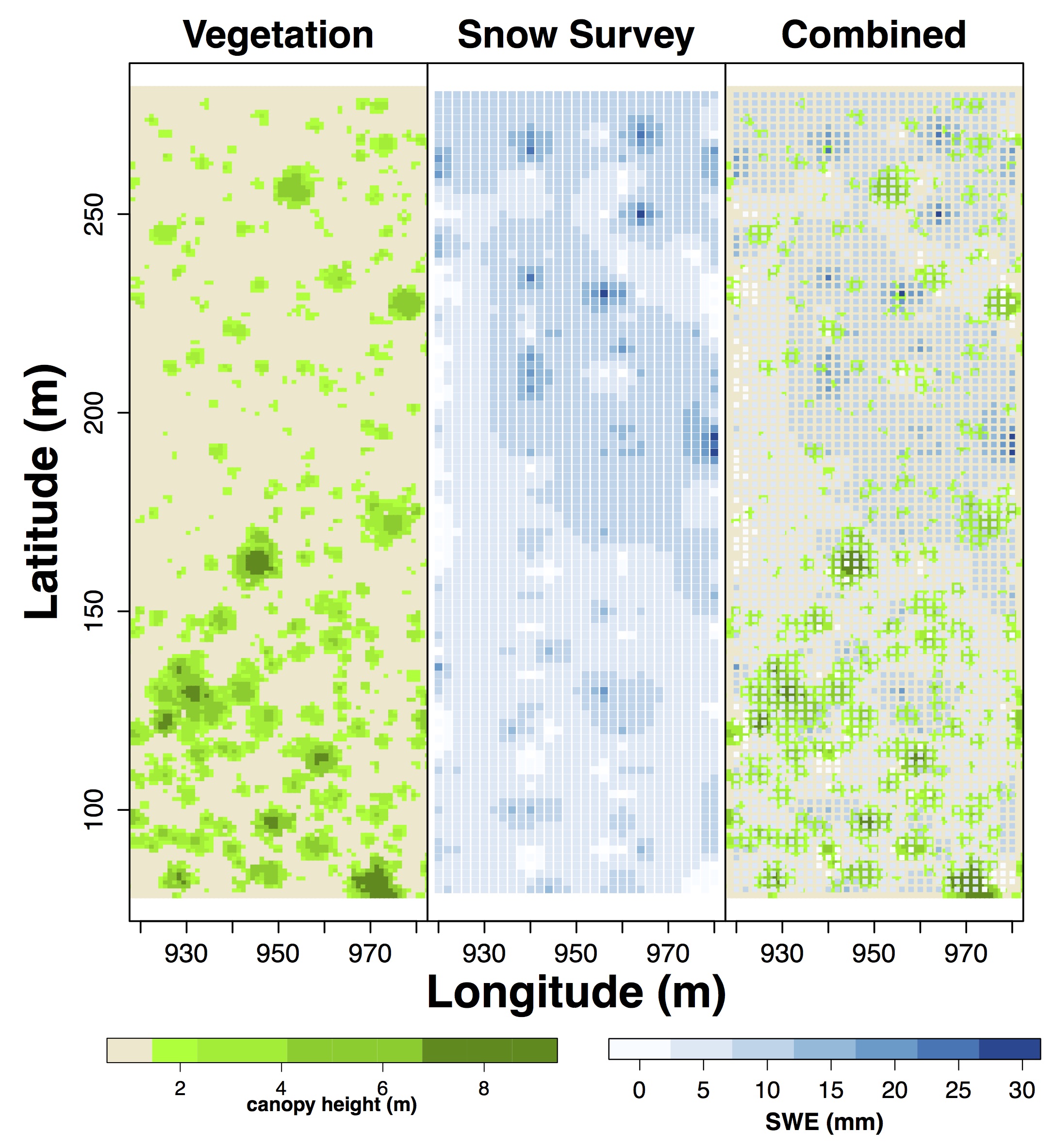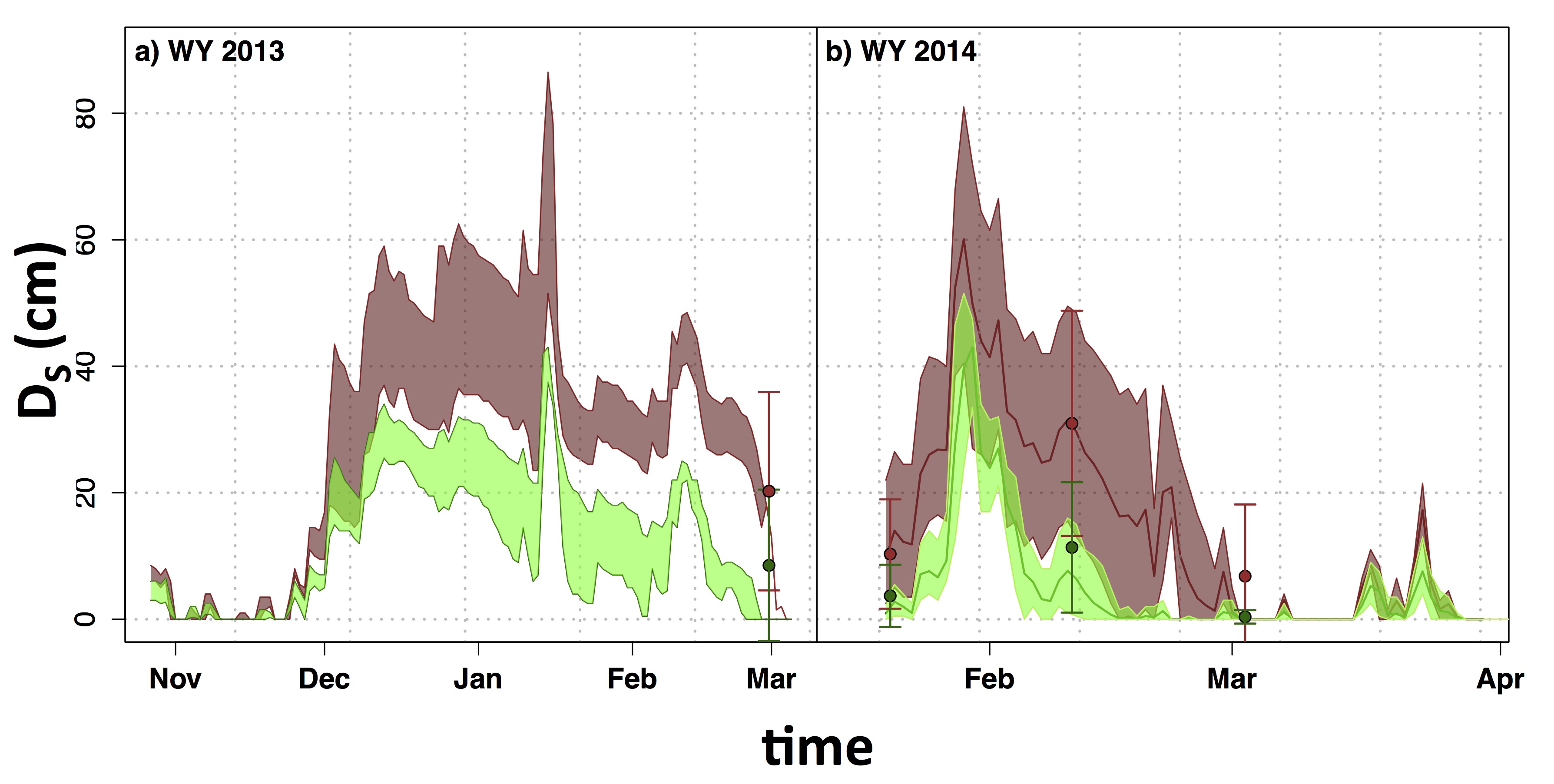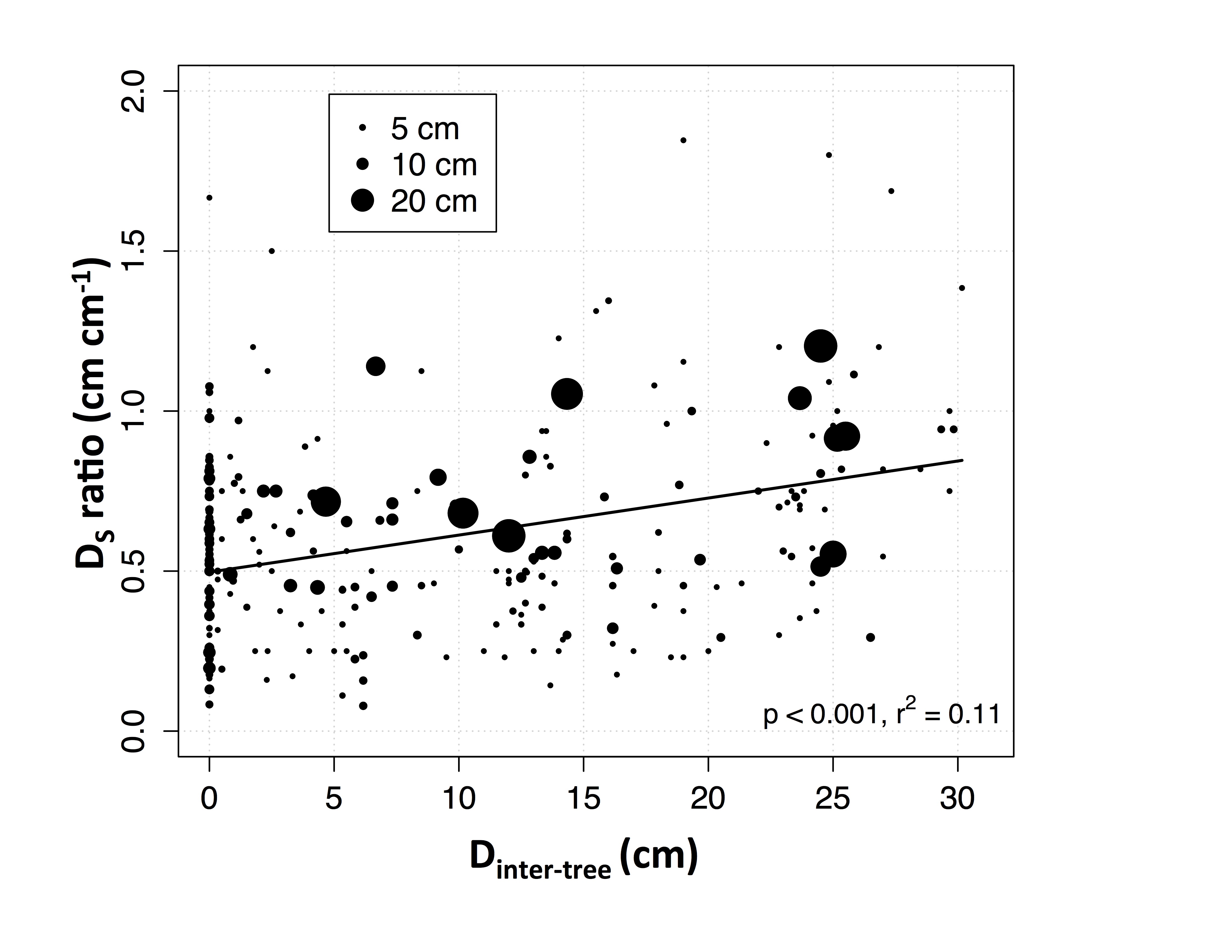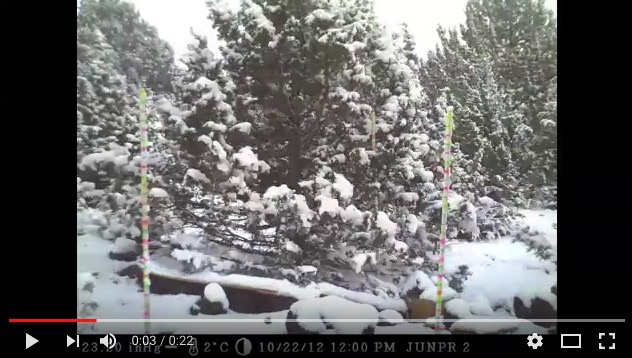Snow
Vegetation affects snow accumulation and snow melt. Differences in snowpack accumulation vary with canopy opening size, with smaller openings resulting in lower accumulation due to adjacent tree canopy interception, and larger openings reducing accumulation due to increased blowing snow (Pomeroy and Goodison 1997). The ratio of tree height to opening size that results in the highest accumulation in the opening has been shown at 5 times in Colorado (Troendle and Charles 1980) and 2 to 3 times in Alberta (Swanson 1988). López-Moreno and Latron (2008) observed that for increasing forest density in snow-dominated temperate mountains, there was a decrease in snow accumulation (López-Moreno and Latron 2008). While these studies were in boreal, pine, and mixed conifer-deciduous forests that are very different from juniper areas, this information still reveals that snow accumulation varies with opening size. Our study at RCEW included plot and tree level measurements of snow measurements.
Plot Level Snow Dynamics
Similar to previous studies in woodlands with seasonal snowpack, snowpack builds up in areas with fewer trees compared to areas with more trees. We can see in our plot at RCEW, that the southern portion of the plot with more juniper trees, there is a lower snowpack, compared to the northern portion of the plot with fewer trees but a larger build up snowpack.
Juniper cover and snowpack figure
 Figure caption: vegetation is from a canopy height model derived from LiDAR data. Snowpack is derived from snow surveys on March 14, 2013, which was nine days after peak snowpack (SWE) based on a continuous measurement at the site climate station.
Figure caption: vegetation is from a canopy height model derived from LiDAR data. Snowpack is derived from snow surveys on March 14, 2013, which was nine days after peak snowpack (SWE) based on a continuous measurement at the site climate station.
Tree Level Snow Dynamics
Juniper impact snowpack dynamics at the tree level as well. Trees intercept snow which reduces the amount of snowpack below trees. But what is often ignored is that snows absorb sunlight which is then emitted to the snowpack below the tree which preferentially melts the snow. In the figure below, we can see that the snowpack below the tree builds up to a similar extent after a snow storm. But snow melts at a faster rate below the trees than in the interspace. Indeed, in water year (WY) 2014, we see that the snow is transient below the tree, but persists in the interspace until March.
Seasonal snowpack below juniper and in interspace
 Figure caption: Lines indicate the average snow depth in the interspace (brown) and under the juniper trees (green) for A) water year (WY) 2013 and B) WY 2014. The bold green and brown lines are the average and shaded region outside the bold lines are the maximum and minimum snow depth. The circles are the average snow depth under trees and in the interspace during a snow survey and the error bars are one standard deviation from those snow survey depth measurements. Due to camera failure, no average was plotted for WY 2013 (Niemeyer et al., 2016, Hydrological Processes).
Figure caption: Lines indicate the average snow depth in the interspace (brown) and under the juniper trees (green) for A) water year (WY) 2013 and B) WY 2014. The bold green and brown lines are the average and shaded region outside the bold lines are the maximum and minimum snow depth. The circles are the average snow depth under trees and in the interspace during a snow survey and the error bars are one standard deviation from those snow survey depth measurements. Due to camera failure, no average was plotted for WY 2013 (Niemeyer et al., 2016, Hydrological Processes).
Another interesting impact that trees have on snowpack dynamics is preferential deposition of snow. Although trees do intercept snow, they also form tree wells or depressions in the snow surface at the base of trees. When another snow storm occurs, this allows for snow to be preferentially deposited under the tree. In the figure below, the D_s ratio is the ratio of snow under the three to under the interspace. So a D_s ratio of below 1 means more snow is deposited in the interspace than under the tree, which is what we typically expect. And a greater D_s ratio, means more snow is deposited under the trees compared to the interspace. The x-axis is simple the snow depth increase for each storm in the interspace (D_inter_tree). We see the difference in depth between the tree and interspace (D_inter_tree) gets larger, the more similar the snow deposition between the interspace and under the trees.
Snow deposition figure
 Figure caption: This figure shows the ratio of snow depth under the tree to interspace (D_s ratio) for each event (y-axis). The x-axis is data is the difference in snow depth between the interspace and under the tree (D_inter-tree) before the snow event. Therefore, as we move right on the x-axis, it representes greater depth of snow in the interspace than under the tree (i.e. a deeper "tree well"). The circle size for each point correlates with the depth of snow deposition in the interspace storm (Niemeyer et al., 2016, Hydrological Processes).
Figure caption: This figure shows the ratio of snow depth under the tree to interspace (D_s ratio) for each event (y-axis). The x-axis is data is the difference in snow depth between the interspace and under the tree (D_inter-tree) before the snow event. Therefore, as we move right on the x-axis, it representes greater depth of snow in the interspace than under the tree (i.e. a deeper "tree well"). The circle size for each point correlates with the depth of snow deposition in the interspace storm (Niemeyer et al., 2016, Hydrological Processes).
Below is a link to a video (click the photo) of a snow storm that occured in October of 2012. You can see the snow interception, and subsequent snowmelt from the tree limbs, interspace, and below the tree.
Information on this page is based on this publication, where you can find more detailed information about this study.
Citations
López-Moreno, J. I., and J. Latron. 2008. Influence of canopy density on snow distribution in a temperate mountain range. Hydrological Processes 22:117–126.
Niemeyer, R. J., T. E. Link, M. S. Seyfried, and G. N. Flerchinger. 2016. Surface water input from snowmelt and rain throughfall in western juniper: potential impacts of climate change and shifts in semi‐arid vegetation. Hydrological Processes 30: 3046-3060.
Pomeroy, J. W., and B. E. Goodison. 1997. Winter and Snow. Page in W. G. Bailey, T. R. Oke, and W. R. Rouse, editors. The Surface Climates of Canada. McGill-Queens.
Swanson, R. H. 1988. The effect of in situ evaporation on perceived snow distribution in partially clear-cut forests. Pages 87–92 Proceedings of the Western Snow Conference.
Troendle, C. A., and F. Charles. 1980. An approach to water resources evaluation of non-point sllvlcultural sources. United States Environmental Protection Agency. Pages 1–173. United States Environmental Protection Agency, Athens, GA.
